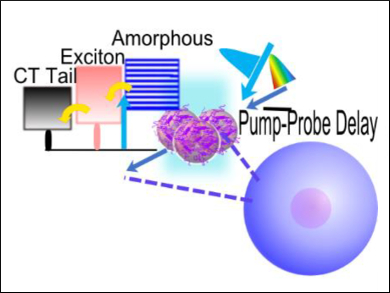Biocompatible polymer nanoparticles can behave like light actuators when they are internalized in living cells, tissues, or organisms. This makes the cells light-sensitive, and thus, offers a way to control metabolic functions using light.
Recently, Guglielmo Lanzani and colleagues, Center for Nano Science and Technology, Milan, Italy, have induced light sensitivity in the eyeless freshwater polyp Hydra vulgaris by using semiconducting polythiophene nanoparticles. The researchers were able to control the animals’ behavior, gene regulation, and cell regeneration [1]. The origin of the coupling between the photoexcited polymer nanoparticles and the living cell is, however, still largely unknown.
The team has shed light on this photoexcitation scenario by studying the photophysics of the polythiophene nanoparticles in biological media. In contrast to polymer films of the same material, the nanoparticles show a distinct absorption band in the low-energy region. This band is caused by charge transfer (CT) states generated by the polarization of loosely bound polymer chains on the nanoparticle surface due to interactions with the biological media. These CT states, even in low concentrations, might lead to a photocatalytic activity in cells and a non-negligible biological reaction, while being below the toxicity threshold.
The results indicate that engineering the morphological properties of polymer nanoparticles might lead to an enhancement of their photoexcitation characteristics, which could boost the particles’ impact on biological applications.
- The Photo-Physics of Polythiophene Nanoparticles for Biological Applications,
Ilaria Bargigia, Elena Zucchetti, Ajay Ram Srimath Kandada, Miguel Moreira, Caterina Bossio, Walter Wong, Paulo Miranda, Paolo Decuzzi, Cesare Soci, Cosimo D’Andrea, Guglielmo Lanzani,
ChemBioChem 2018.
https://doi.org/10.1002/cbic.201800167
Reference
- [1] Semiconducting polymers are light nanotransducers in eyeless animals,
Claudia Tortiglione, Maria Rosa Antognazza, Angela Tino, Caterina Bossio, Valentina Marchesano, Antonella Bauduin, Mattia Zangoli, Susana Vaquero Morata, Guglielmo Lanzani,
Sci. Adv. 2017, 3, e1601699.
https://doi.org/10.1126/sciadv.1601699




